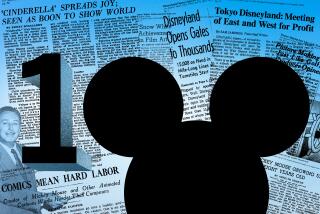Franklin’s Business Is in Mint Condition
- Share via
FRANKLIN CENTER, Pa. — What does the Vatican have in common with Graceland?
The unlikely answer is that both have established licensing agreements with the Franklin Mint, the same company that sells Scarlett O’Hara plates and Civil War chess sets in TV Guide. So have the Philadelphia Museum of Art and the Louvre.
And it isn’t just museums. Corporations including Coca-Cola, McDonald’s, General Motors, Campbell’s Soup, Pillsbury and Parker Brothers have deals that put their names on Franklin-made plates, figurines and other collectibles.
The suburban Philadelphia mint also has Hollywood connections, making items for Warner Bros., MGM, Viacom, Hanna-Barbera, Paramount and 20th Century Fox.
A partnership between corporate America and this collectibles marketer is a natural. “They all want to take advantage of our huge promotional power,” said Marvin D. Melnikoff, Franklin’s vice president of sponsor relations and licensing.
“Corporate collectibles are hot,” Melnikoff said. “The partners come to us more often than we’re going to them.”
Franklin’s sprawling, 188-acre headquarters in picturesque Delaware County is meant to be a center of creativity. The company has its own art collection, which includes Norman Rockwell’s “America,” Andy Warhol prints and several signed, original Picasso sketches.
“By surrounding our artists with beauty we believe they’ll be inspired to create beauty of their own,” spokesman Jack Wilkie said during a recent tour of the grounds. “It seems to work.”
*
Sculptor Bob Murphy is one of several dozen artisans working in an area of the mint that resembles Santa’s workshop.
“We’re a proud group,” Murphy said. “Proud of our creativity, skill, attention to detail. And we’re proud to work for this company. Just because we aren’t starving, doesn’t mean we’re not artists.”
Once Franklin’s creative staff has developed a product, the mint’s promotional wing takes over, and plates, thimbles, spice jars and other products start appearing in well-placed ads. The company’s in-house advertising agency employs nearly 100 people and includes a complete photography studio and film-processing lab.
Through TV Guide, Parade and USA Weekend magazines alone, Franklin reaches more than 70 million households each week. Anyone hesitant to order by direct mail or telephone can visit one of 50 Franklin Mint Gallery shops in malls from Beverly Hills to Boca Raton. (The company employs 4,500 people in 20 countries.)
With an estimated $600 million in annual U.S. sales, the mint is outpacing such competitors as the Danbury Mint, Bradford Exchange and Lenox Collections, according to Pam Danziger of Unity Marketing, a Reinholds, Pa., collectibles industry analyst.
The corporate collectibles are a big help. “Our research indicates that ad memorabilia has a tremendous amount of nostalgia appeal, especially among the baby boomers--the new generation of collectors,” Danziger said.
She said it makes sense because collectors are generally age 45 to 60, and because baby boomers are the first real TV generation.
*
Coca-Cola, which has dealt with the mint for two years, has its logo on such items as Santa Claus plates and limited edition dolls.
“People recall the Coke commercials and jingles they grew up with and they associate the company’s logos with happy times,” Danziger said. “The mint’s products have adapted accordingly.”
A Coca-Cola spokeswoman said the company was pleased with its licensing arrangement with Franklin Mint.
“The items we have licensed with them have been very well-received by consumers,” Kerry Traubert said. “The Franklin Mint has been very good to Coca-Cola.”
When the company was founded in 1964 by Joseph Segel, who later founded the home shopping channel QVC, more than 95% of the business was coins and ingots (the figure is closer to 1% now).
Acquired from Warner Communications in 1985 by Stewart and Lynda Resnick for $168 million, the mint now develops some 900 new products each year.
“We listen to the market and to our collectors to find our new product lines. We don’t put out just anything,” Wilkie said. “We make things that you’d be proud to hand down--heirlooms, not garage sale fodder.”
Wilkie shrugs off criticism that the products are a poor investment, as was suggested in a recent Wall Street Journal report and in a damaging “60 Minutes” segment back in 1978.
“We’re not selling for speculators,” he said. “We create the products because they’re beautiful. They’re what you like.”




